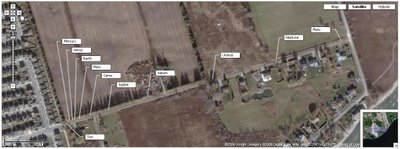When I was a kid, I tried building a model. I set the scale so to fit on my (small) desk. But quickly realised that scale was too small: I couldn't see the inner planets or Pluto. If I remember correctly, I reset the scale, but decided not to build it; I just looked at the numbers...
So, this Saturday morning, I recruited the troops! I got Evan and Colin to feed us adults the diameter of planets (in kilometres). Looking around the kitchen, I suggested we use an old soccer ball for the Sun. Using the circumference and a calculation with Pi, we figured out the diameter.
Now we had our scale factor: 0.000 000 000 139.
We used the following objects for the planets (and asteroids):
| Mercury | poppy seed |
| Venus | dill seed (small) |
| Earth | dill seed |
| Mars | dill seed piece |
| Ceres in asteroid belt | ground pepper! |
| Jupiter | hazelnut |
| Saturn | "standard" size marble |
| Uranus | pencil eraser end |
| Neptune | pencil eraser end |
| Pluto | poppy seed |
Pluto as a poppy seed was a little too big. It needed to be about half or a quarter the size.
Then we calculated the distances. To finally get the sense of the "space" in the solar system, we headed out to a nearby gravel road where Terry paced out the planets. At over 600 metres from "the Sun" we placed Neptune. We took the average distance for Pluto, to our scale now another 195 metres from Neptune, and we reached the end of the road (Cindy ironically pointing out the dividing line between Ajax and Whitby).

Something occurred to me. Here, so far away from the Sun, why would these planets stay near and orbit the star? Gravity must be strong...
It was astonishing.
The enormous space between the planets. The tiny, miniscule, size of the planets, compared to the Sun, compared to the distances. And the reach of gravity.
Astonishing.


No comments:
Post a Comment